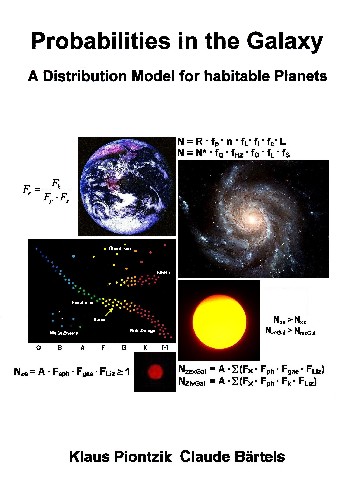 |
Analogous to the previous basic
model, equation 6.3 for technological
civilizations on an "Earth 2" in
solar-like systems can be extended to such an
extent that it applies to general star systems
with habitable, earth-like planets that have
produced civilizations:
|
| |
|
| 8.4.1 Equation |
Nzex
= A · FX ·
Fph ·
Fgae ·
FLiz |
The
number NzexGal
of all star systems, with habitable, earth-like planets,
with technological civilizations, in the galaxy is then
the sum across all spectral classes:
| 8.4.2 Equation |
NzexGal
= ∑ Nzex
= A · ∑ (FX
· Fph
· Fgae
· FLiz) |
|
Equation
8.4.2 is the extension of equation system 6.3.3 and
contains all planetary and biological factors that can
influence the development of a civilization by an
intelligent species, on an "Earth 2" in the
galaxy.
In the further course of this paper, Equation 8.4.2 is
therefore referred to as the "General Basic Model".
Strictly speaking, the probabilities Fph, Fgae,
FLiz would have to be determined individually
for each spectral class.. Since this is not yet possible
today and in the near future, however, a rough
calculation or maximum estimate can be achieved by
assuming, in an initial approach, the same or similar
distributions.
Assuming that non-sunlike stars also have an equal or
similar distribution for technological civilizations, one
can make a rough estimate of how many systems with
habitable "Earths 2" that carry civilizations
could exist.
| 8.4.3 Approach |
In star systems that are not
sun-like, there are probably the same or similar
distributions, for earth-like planets, with
civilizations as in sun-like systems. |
The
number NzexGal of
all star systems with habitable, earth-like planets, with
technological civilizations in the galaxy (∑ Fx=1),
is then approximated:
| 8.4.4 Equation |
NzexGal
= ∑ Nzex
≈ A · Fph
· Fgae
· FLiz |
Inserting all values (Fe = 0.1) into equation
8.4.4:
NzexGal1 = (100-300)·109 · 1:4200
· 1:69 · 1:1001
NzexGal1
= 345 – 1034 technological civilizations
Inserting all values (Fe = 0.01) into equation
8.4.4:
NzexGal2 = (100-300)·109 · 1:4200
· 1:691 · 1:1001
NzexGal2
= 35 – 104 technological civilizations
The two results can then be summarized to the following
statement:
| 8.4.5 Theorem |
The number of star systems
in the galaxy, with Earth-like planets, in
habitable zones that could carry civilizations,
is most likely between 35 and 1034. |
The
probability of finding an Earth-like planet with a
technological civilization is then:
| 8.4.6 Definition |
FzexGal
= Fph
· Fgae ·
FLiz |
FzexGal
= 1:4200 · (1:69-1:691) · 1:1001
FzexGal = 1:290,0892,800 –
1:2,905,102,200
Only every 290.089 millionth - 2.905 billionth
star system then has an Earth-like planet, with a
technological civilization.
|
